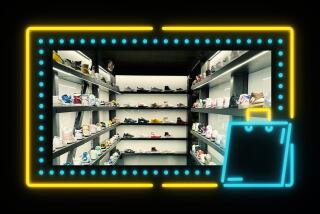Garage Sales Becoming a Rich Treasure Hunt : Santa Barbara’s Rolls-Royces of Rummage Include Four Major Fund-Raisers for Charity
SANTA BARBARA — Walk into Bill Gardner’s spacious home and you can’t miss it--a perfect replica of the royal barge of Thailand. The gold-leafed structure sits on green felt in its own plexiglass case with appropriate, museum-quality spotlighting, a thing of beauty and a joy forever to Gardner who admittedly has everything--and obviously more--than he needs.
He got it at a museum sale. Every year since 1948 the Santa Barbara Museum of Art has had a Treasure Sale. For three days in October--always the third weekend--the public can browse and buy, at unheard of prices, the sublime, the ridiculous and everything in between.
Not far from Gardner lives Muriel LaTourette. Immediately upon entering her large, Moroccan-style home, one sees an enormous and beautiful Middle-Eastern mural, and like Gardner’s barge, the focal point for the rest of the decor.
Both items are remembered well by Treasure Sale staffers because they wondered, as they often do, who would buy this stuff. As Gardner recalls: “It (the barge) looked so awful, you wouldn’t believe it; it had electrician’s tape holding it together.” And Muriel LaTourette’s mural had originally been peeled from the wall of a silent screen star’s home, and was rolled up to rip and rot.
There is something very basic in these two illustrations that accounts for the enormous and growing popularity of the great American “garage” sale.
What started out as a way to clean the attic has become a booming industry, a nearly $2-billion-a-year phenomenon that appeals to the instincts for “rooting and ferreting,” as one sale veteran put. In a three-year study of this backyard marketplace, State University of New York doctoral (anthropology) student Gretchen Herrman and sociologist Stephen Soiffer found that more than a penchant for a bargain, these sales were popular because they incorporated socializing and skill, with emphasis on skill.
Perhaps because of its not-too-big-not-too-small size, because of its solid core of charitable organizations, and certainly because of its higher-than-average population of the rich and famous, Santa Barbara has its fair share of what could only be considered the Rolls-Royces of rummage sales.
The qualifying four include the Treasure Sale, the Clothes Gallery (April 19-21, also sponsored by the Museum of Art), Music Academy of the West’s May Madness (May 3-4) and the Junior League’s Rummage Sale (Nov. 1-2).
Anyone who doubts the truth of the adage, “One man’s trash is another man’s treasure” has but to note that among them Santa Barbara’s fabulous four attracted more than 13,000 people last year who divested themselves of about $348,000. All major fund-raisers, the proceeds go to programs operated by these nonprofit organizations. But the sales provide a more immediate service as well, serendipitous purchases aside.
From a practical standpoint, people who are on a limited budget can literally outfit a family, top-to-toe, in quality merchandise (none of the organizations sell ripped, dirty, stained or otherwise tattered clothing) for what it might cost at moderate retail prices to clothe just one.
The Junior League’s Jo Wideman says that, “We have families of four and five come year after year to buy their clothes. One of the reasons we haven’t raised our prices much over the years (Junior League is the oldest annual sale beginning in 1928) is that even though we use the profits for many community projects, we consider the event itself a community service. Individuals and families can buy good things that they need but could otherwise not afford.”
Nancye Andriesse, the museum’s Clothes Gallery and Treasure Sale manager for seven years, put together a basic wardrobe for a professional woman that came to $75 including underwear and accessories. She then furnished a one-bedroom apartment with “good” furniture, major appliances and linens for $450.
No special treatment is given to dealers or collectors. In all cases, organizers say these are equal-opportunity bargains but that because of the nature and reputation of the merchandise donated (a large portion from estates) dealers are usually the ones encamped outside the doors at 4:30 a.m.
“You can always tell the professionals and the dealers,” Wideman says. “They just have a look about them. They are the hard-core shoppers--they want the most of the best the fastest. Some come in with boxes strapped through their belt loops.”
Estelle Ritter, chairman of the Music Academy’s May Madness event, agrees. “You can spot them right away. I remember one pair who, the first year they came, gave us this story about their daughter’s house burning down just after her wedding. They didn’t have much money but they wanted to buy her some really nice things to replace the wedding gifts that had burned.
“The catch was,” Ritter says, “they wanted to buy all of these things at half-price. We don’t reduce prices, it’s policy. We’ll take bids on an item the last day, but if they aren’t within reason, we’ll hold an item over until the next year.”
The saga continued on the Monday when everything was being packed up for storage. “Here they come, looking even more sad than they had the previous days, but it got them nowhere. They came back a second year with the same story and when I saw them walking through the door the third consecutive year I went up to them and said, ‘It’s so nice to see you again and I hope you enjoy yourselves. Just please spare us the story about your daughter’s house burning down!’ Nobody saw them last year.”
Not all professional shoppers use questionable tactics. Another May Madness regular is a Pasadena caterer who arrives in a limousine, stays at the next-door Biltmore, and spends two days examining and purchasing linens for her business. “She is so knowledgeable about linens,” Ritter says, “it’s like talking with a book. Did you know that French nuns weave tighter linens than Spanish nuns?”
Practical pursuits aside, it is the surprises that provide the fun, particularly for the many volunteers who collect and sort throughout the year. Maybe it’s a piece of collector’s china at the bottom of a box of old shoes, an 18-karat gold necklace and bracelet mixed in with a “ton” of junk jewelry, a pair of diamond earrings in an old, frayed evening bag, a rare edition in a box of otherwise sleazy paperbacks, or an antique silver tea service and a mink coat wrapped in a green plastic garbage bag.
“You have to have a pawnbroker’s eye,” Ritter says. All of the organizations have professional appraisers on staff for larger items; because most major donors need and get formal, signed documents for IRS purposes. But a working knowledge of current market value doesn’t hurt.
Nancye Andriesse volunteered for years at both the Clothes Gallery and Treasure Sale before being hired full-time. As a teen-ager she worked for a Santa Barbara estate sale appraiser and now, because she doesn’t have a lot of time to shop the retail stores, “I get every catalogue ever printed.”
Defy Traditional Appraisal
There are some items, however, that defy any traditional method of appraisal. They are called “others” and form a category somewhat akin to the ubiquitous “Miscellaneous” file. Some “others” include a racehorse, an elevator, a U.S. Mail Jeep, a complete marble-topped (and working) soda fountain, a floor lamp made out of 1 million popsicle sticks, iron gates from a church in Spain (“A $20,000 mistake,” Andriesse says, “they were shipped over here and then didn’t fit.”), and the Music Academy still has a five-foot pig just waiting for the right owner.
One can’t help but guess that another reason these events are so well-attended, and do so well is that they run well. If practice makes perfect, consider a combined 107 years of experience among the three groups. Still, the logistics are awesome. Transportation and storage of goods goes on year-round as does itemizing, bagging and tagging. Moving merchandise to the sale site, display, volunteer orientation and security are among details that must be attended.
There is a psychological advantage in being organized, according to Andriesse. “If everything is priced, laid out, and categorized, it makes it easier for the customer. The easier it is, the smoother it goes. The nicer it looks, the nicer the crowd will act.”
There is some vicarious pleasure in glimpsing a piece of other people’s lives through their belongings; getting a heretofore forbidden look at how the other half lives.
A few weeks ago, for example, the museum received an anonymous gift of more than 2,400 items of couture clothing. Many of the items will be included in the upcoming Clothes Gallery sale.
“It was fascinating,” a woman who does most of her shopping in couture salons said, “that one person could have accumulated so many beautiful things. Not half of them were worn. . . .”
More to Read
Sign up for The Wild
We’ll help you find the best places to hike, bike and run, as well as the perfect silent spots for meditation and yoga.
You may occasionally receive promotional content from the Los Angeles Times.






